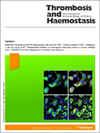新出现的与病毒创新疗法相关的血栓性疾病:从 VITT 到 AAV 基因疗法相关的血栓性微血管病。
IF 5
2区 医学
Q1 HEMATOLOGY
引用次数: 0
摘要
基因疗法是一种治疗危及生命的疾病的方法。尽管基因疗法能改善临床症状,但针对基因递送载体的先天性或适应性免疫反应会影响疗效并导致不良反应。血栓性微血管病(TMA)是一种血栓伴血小板减少综合征(TTS),其特点是微血管病性溶血性贫血、血小板减少和小血管闭塞,已知可由多种药物引起,有报道称这是腺相关病毒(AAV)基因疗法的不良反应之一。TMA 包含一组不同的疾病,其分类和基本机制仍不确定,也缺乏有效的生物标志物。当务之急是确定 TMA 的预测指标,如载体剂量和患者特征,以便在使用基于 AAV 的基因疗法前后识别高危患者。本综述旨在探讨与基于 AAV 的基因治疗相关的 TMA(即溶血性尿毒症综合征、血栓性血小板减少性紫癜和其他与药物相关的 TMA)文献。考虑到另一种与非基因治疗病毒平台(腺病毒、AV COVID-19 疫苗)相关的 TTS(即疫苗诱导的免疫性血小板减少症和血栓形成(VITT))最近受到广泛关注,本综述将讨论 AAV 基因治疗相关的 TMA 机制,并将其与 VITT 的机制区分开来,以避免重复性偏差,并有利于将这两种最近出现的综合征正确定位在药物相关 TTS 的异质群体中。本综述将讨论提高基于 AAV 的基因疗法的安全性和优化管理的策略,这种疗法正在成为治疗不同、严重和通常是孤儿病症的有效疗法。本文章由计算机程序翻译,如有差异,请以英文原文为准。
Emerging thrombotic disorders associated with virus-based innovative therapies: from VITT to AAV-gene therapy-related thrombotic microangiopathy.
Gene therapy is a therapeutic approach for treating life-threatening disorders. Despite the clinical improvements observed with gene therapy, immune responses either innate or adaptive against the vector used for gene delivery can affect treatment efficacy and lead to adverse reactions. Thrombotic microangiopathy (TMA) is a thrombosis with thrombocytopenia syndrome (TTS) characterized by microangiopathic hemolytic anemia, thrombocytopenia, and small vessel occlusion known to be elicited by several drugs that has been reported as an adverse event of adeno-associated virus (AAV)-gene therapy. TMA encompasses a heterogenous group of disorders, its classification and underlining mechanisms are still uncertain, and lacks validated biomarkers. The identification of predictors of TMA, such as vector dose and patient characteristics, is a pressing need to recognize patients at risk before and after AAV-based gene therapy administration. This review aims to explore the literature on TMA associated with AAV-based gene therapy in the context of TMA (i.e., hemolytic-uremic syndrome, thrombotic thrombocytopenic purpura and other drug-related TMAs). Considering the wide attention recently gained by another TTS associated with a non-gene therapy viral platform (adenovirus, AV COVID-19 vaccine), namely vaccine-induced immune thrombocytopenia and thrombosis (VITT), AAV gene therapy-related TMA mechanisms will be discussed and differentiated from those of VITT to avoid recency bias and favor a correct positioning of these two recently emerged syndromes within the heterogenous group of drug-related TTS. The review will discuss strategies for enhancing the safety and optimize the management of AAV-based gene therapy, emerging as an efficacious therapeutic option for disparate, severe, and often orphan condition.
求助全文
通过发布文献求助,成功后即可免费获取论文全文。
去求助
来源期刊

Thrombosis and haemostasis
医学-外周血管病
CiteScore
11.90
自引率
9.00%
发文量
140
审稿时长
1 months
期刊介绍:
Thrombosis and Haemostasis publishes reports on basic, translational and clinical research dedicated to novel results and highest quality in any area of thrombosis and haemostasis, vascular biology and medicine, inflammation and infection, platelet and leukocyte biology, from genetic, molecular & cellular studies, diagnostic, therapeutic & preventative studies to high-level translational and clinical research. The journal provides position and guideline papers, state-of-the-art papers, expert analysis and commentaries, and dedicated theme issues covering recent developments and key topics in the field.
 求助内容:
求助内容: 应助结果提醒方式:
应助结果提醒方式:


